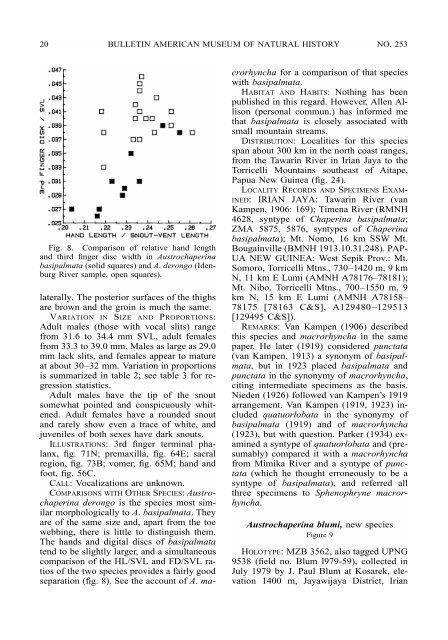SPHENOPHRYNE - American Museum of Natural History
SPHENOPHRYNE - American Museum of Natural History
SPHENOPHRYNE - American Museum of Natural History
You also want an ePaper? Increase the reach of your titles
YUMPU automatically turns print PDFs into web optimized ePapers that Google loves.
20 BULLETIN AMERICAN MUSEUM OF NATURAL HISTORY NO. 253<br />
Fig. 8. Comparison <strong>of</strong> relative hand length<br />
and third finger disc width in Austrochaperina<br />
basipalmata (solid squares) and A. derongo (Idenburg<br />
River sample, open squares).<br />
laterally. The posterior surfaces <strong>of</strong> the thighs<br />
are brown and the groin is much the same.<br />
VARIATION IN SIZE AND PROPORTIONS:<br />
Adult males (those with vocal slits) range<br />
from 31.6 to 34.4 mm SVL, adult females<br />
from 33.3 to 39.0 mm. Males as large as 29.0<br />
mm lack slits, and females appear to mature<br />
at about 30–32 mm. Variation in proportions<br />
is summarized in table 2; see table 3 for regression<br />
statistics.<br />
Adult males have the tip <strong>of</strong> the snout<br />
somewhat pointed and conspicuously whitened.<br />
Adult females have a rounded snout<br />
and rarely show even a trace <strong>of</strong> white, and<br />
juveniles <strong>of</strong> both sexes have dark snouts.<br />
ILLUSTRATIONS: 3rd finger terminal phalanx,<br />
fig. 71N; premaxilla, fig. 64E; sacral<br />
region, fig. 73B; vomer, fig. 65M; hand and<br />
foot, fig. 56C.<br />
CALL: Vocalizations are unknown.<br />
COMPARISONS WITH OTHER SPECIES: Austrochaperina<br />
derongo is the species most similar<br />
morphologically to A. basipalmata. They<br />
are <strong>of</strong> the same size and, apart from the toe<br />
webbing, there is little to distinguish them.<br />
The hands and digital discs <strong>of</strong> basipalmata<br />
tend to be slightly larger, and a simultaneous<br />
comparison <strong>of</strong> the HL/SVL and FD/SVL ratios<br />
<strong>of</strong> the two species provides a fairly good<br />
separation (fig. 8). See the account <strong>of</strong> A. ma-<br />
crorhyncha for a comparison <strong>of</strong> that species<br />
with basipalmata.<br />
HABITAT AND HABITS: Nothing has been<br />
published in this regard. However, Allen Allison<br />
(personal commun.) has informed me<br />
that basipalmata is closely associated with<br />
small mountain streams.<br />
DISTRIBUTION: Localities for this species<br />
span about 300 km in the north coast ranges,<br />
from the Tawarin River in Irian Jaya to the<br />
Torricelli Mountains southeast <strong>of</strong> Aitape,<br />
Papua New Guinea (fig. 24).<br />
LOCALITY RECORDS AND SPECIMENS EXAM-<br />
INED: IRIAN JAYA: Tawarin River (van<br />
Kampen, 1906: 169); Timena River (RMNH<br />
4628, syntype <strong>of</strong> Chaperina basipalmata;<br />
ZMA 5875, 5876, syntypes <strong>of</strong> Chaperina<br />
basipalmata); Mt. Nomo, 16 km SSW Mt.<br />
Bougainville (BMNH 1913.10.31.248). PAP-<br />
UA NEW GUINEA: West Sepik Prov.: Mt.<br />
Somoro, Torricelli Mtns., 730–1420 m, 9 km<br />
N, 11 km E Lumi (AMNH A78176–78181);<br />
Mt. Nibo, Torricelli Mtns., 700–1550 m, 9<br />
km N, 15 km E Lumi (AMNH A78158–<br />
78175 [78163 C&S], A129480–129513<br />
[129495 C&S]).<br />
REMARKS: Van Kampen (1906) described<br />
this species and macrorhyncha in the same<br />
paper. He later (1919) considered punctata<br />
(van Kampen, 1913) a synonym <strong>of</strong> basipalmata,<br />
but in 1923 placed basipalmata and<br />
punctata in the synonymy <strong>of</strong> macrorhyncha,<br />
citing intermediate specimens as the basis.<br />
Nieden (1926) followed van Kampen’s 1919<br />
arrangement. Van Kampen (1919, 1923) included<br />
quatuorlobata in the synonymy <strong>of</strong><br />
basipalmata (1919) and <strong>of</strong> macrorhyncha<br />
(1923), but with question. Parker (1934) examined<br />
a syntype <strong>of</strong> quatuorlobata and (presumably)<br />
compared it with a macrorhyncha<br />
from Mimika River and a syntype <strong>of</strong> punctata<br />
(which he thought erroneously to be a<br />
syntype <strong>of</strong> basipalmata), and referred all<br />
three specimens to Sphenophryne macrorhyncha.<br />
Austrochaperina blumi, new species<br />
Figure 9<br />
HOLOTYPE: MZB 3562, also tagged UPNG<br />
9538 (field no. Blum l979-59), collected in<br />
July 1979 by J. Paul Blum at Kosarek, elevation<br />
1400 m, Jayawijaya District, Irian
















